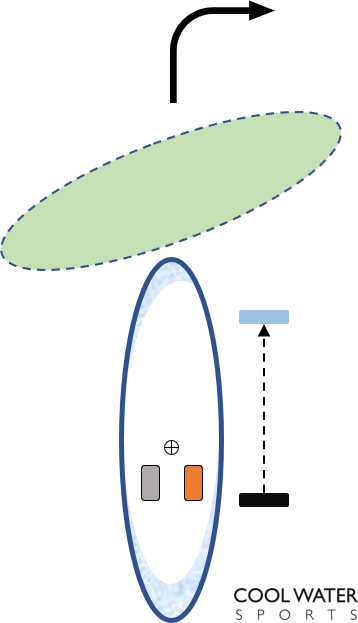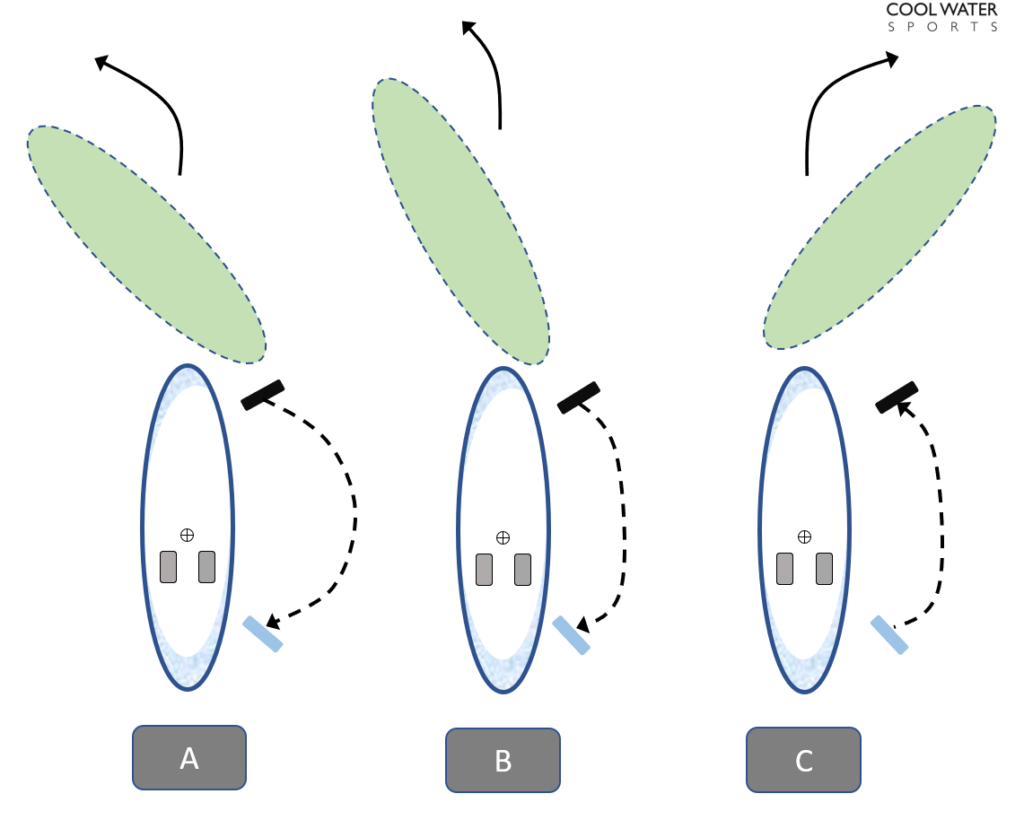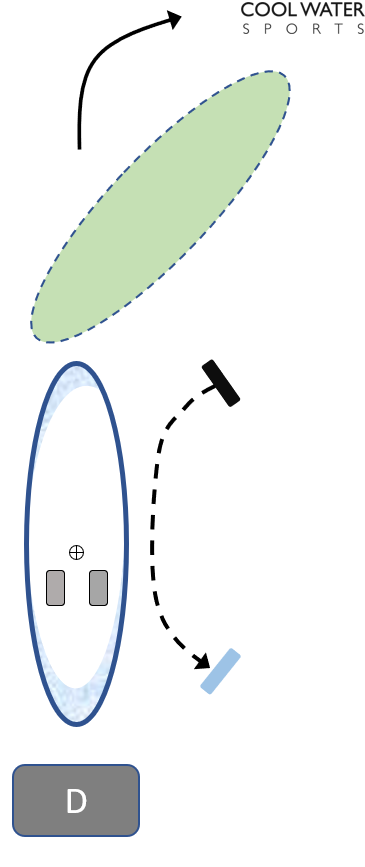Stand Up Paddling Tips – the fifth part of our “How to Stand Up Paddle Board”.
Learn the most essential things you need to know about SUP Paddle Technique.
In the fifth episode, we will show you everything you need to know about maneuvering your Stand Up Paddle Board correctly and efficiently
In this article, we will answer the most critical questions about how to manoeuvre on a SUP Board:
- How do you actually steer a SUP board?
- Are there any other options than simply manoeuvring by paddling on one side?
- How can I place the SUP sideways?
Turning the corner accurately with your SUP? Here, you will find the answers! And we bring together what we’ve explained about the different standing positions on a SUP and how to paddle correctly.
So take 5 minutes…

Our Stand up paddle board technique graphics – to make it easily understandable
In order to explain the different techniques a little better, we will also use the following graphics in this section of the technique guide. These should help you to understand the descriptions in the instructions better.

Important Remarks:
In our stand up paddle instructions, we assume that you own or rent the required material. If not, check out our overview of boards and the Buying Guide!
As always, the “Safety Disclaimer” applies: stand up paddling is a water sport! You should, therefore, always adhere to the most critical safety rules. If you do not know them yet, check them out quickly here.
Why is it essential to know different techniques for manoeuvre a SUP?
It is clear that with paddling on one side, and even if this is done perfectly, the board moves on a curve (as a reminder, check the article about how to paddle straight ahead correctly).
So there are two main reasons why you should learn different techniques to steer your Paddleboard:
First of all, they give you the opportunity to reduce and adapt the amount of side changes during paddling. This is helpful either when you want to minimise the loss of speed during the paddle change or if you need to relieve the physical strain on one side of your body.
And secondly, you are probably also underway in areas where you have to avoid obstacles or drive “precisely.”
Here, the following paddle strokes will help you:
- Reverse stroke (also called stop stroke)
- Sweep stroke
- C-stroke
- Draw stroke
We will now show you what they are for and how they work correctly. After all, the goal is always for you to be as efficient as possible on your board and feel safe in all situations. Believe us: this increases the fun of the SUP significantly!
Option 1: The reverse stroke or How to brake on the SUP!
If you are travelling at full speed and you suddenly have a rock, swimmer or another obstacle in front of you, you will be glad to have this anchor.
The goal of the reverse stroke is to brake, the SUP board, as quickly as possible.
Note: braking will cause the board to rotate directly to the paddle side. This also helps you to slow down the forward movement as quickly as possible.
How do you carry out the reverse stroke?
Plant the paddle into the water behind your feet.
Your shaft arm now presses the paddle blade against the oncoming water, that is, in the direction of the bow. You can easily lean on the paddle with your top hand and thus support your shaft arm.

Try to put a little more weight on your foot on the paddle side. The edge insert provides additional support for fast turning and braking.
This also means that the farther away from the board you push your paddle into the water, the tighter the board rotation becomes and the faster you brake.
But of course, it is only as long as you can really press against the water, as the leverage for your shaft arm decreases the farther out you stroke. Bonus tip: If your board has not yet turned entirely or slowed down after the reverse stroke, you can complete the manoeuvre with one or two paddle moves on the side on which you made the reverse stroke.
Option 2: The sweep stroke and the C-stroke or How to steer from both sides
With the sweep stroke, you can steer your board in different rotation directions. Depending on the direction from which you perform the paddle stroke, you can also steer on both sides of your board without changing the paddle side. We’ll show you how to do that here.
What is the sweep stroke, and how does it work?
The word “sweep” actually says how it works. An arc movement of the paddle between the catch (i.e. start of the paddle pull) and exit (end of the turn) creates an angular momentum in the SUP board. The paddle stroke thus begins and ends near the board along a curved track. This also means that the further you submerge the paddle, the more your board will rotate (see graphs A and B).
Here are two general possibilities:
- Arc in the direction of travel (graphics A and B): the board rotates away from the paddle side
- Curve against the direction of travel (graphic C): the board turns towards the paddle side (actually just a “bigger” reverse stroke)

The standing position and foot load should be as balanced as possible in all variants.
And don’t forget:
if you execute the arc stroke against the direction of travel (Figure C) when you have already picked up speed, you will brake firmly. Usually, paddling against the direction of travel is used when you still want to manoeuvre while standing or, of course, when you deliberately want to brake.
SUP Bonus Tip:
If you perform the sweep-stroke, you can paddle a little further behind your feet than if you want to move straight ahead. Thrusting the paddle further away from the sweet spot will provide more momentum. However, as with a straight line, some efficiency is indeed lost when paddling behind the feet. This also means you should not overdo it here.
How to steer the SUP board to the other side WITHOUT changing sides and losing speed – the C-Stroke
As shown above, you can steer your board away from the paddle side with the curve in the direction of travel without losing much speed. We show you how to steer the board to the other side without changing the side of the paddle here.
Now the C-stroke comes into play:

The C-stroke (graphic D) is very similar to the sweep stroke. The only difference is that the closed side of the curve here faces the board.
This gives the board momentum to the paddle side: that is, the board rotates accordingly to this side.
PS: Even with the C-stroke, you should make sure that you stroke the paddle a little longer than with the standard straight-ahead stroke.
With the sweep stroke and the C-stroke, you can steer your board precisely to both sides without having to change the paddle side. If you now combine this with the edge load technique or the J-stroke, you have everything you need to be able to manoeuvre flawlessly on the one hand and to be fast and efficient on the other hand.
SUP Bonus Tip: The draw stroke (graphic E) – or how to place the SUP board sideways
In some situations, it can also be helpful if you can place the board a little sideways.
A good example is if you want to land at a jetty but are still a little too far away to stay dry.
In such situations, you can apply a draw stroke:

You should insert the paddle at about the height of the sweet spot parallel away from the board and then pull it straight towards the board. This allows you to move the board sideways in this direction (Graphic E).
When doing the draw stroke, make sure that the angle between the paddle blade and the shaft points away from the board. Additionally, try to balance as evenly as possible with both feet during this manoeuvre and not tilt towards the paddle side. This positions the board better, and you don’t have to pull the edge through the water.
Bonus SUP Tip:
If you start the draw stroke before or after the sweet spot, you can not only move the board sideway but also rotate it slightly at the same time (graphics E2 and E3).
Conclusion and summary
For the training on the water, take the following important information from the graphic with you on the way:
The most important techniques for maneuvering and steering
Reverse stroke, sweep stroke, C-stroke and draw stroke
Technique 1: Reverse stroke
You need this technique to brake or turn quickly. Insert the paddle into the water directly behind your feet and press against the current. Also, make sure that you lean on the paddle slightly and put a little more weight on the paddle side.
Technique 2: Sweep stroke in the direction of travel
With this technique, you can steer your board away from the paddle side on the one hand and continue to maintain your speed on the other. You do not stroke the paddle straight past the board as with a standard paddle stroke, but stroke in a curve. The curve starts and ends at the board.
You can determine the radius of your drive curve by the radius of the arc. Also, make sure that you start your paddle stroke from a little farther behind your feet than with regular paddling.
Technique 3: Sweep stroke against the direction of travel
With this technique, you can steer your board towards the paddle side. This technique is a combination of stopping and turning in the direction of travel. It is generally the same as the normal sweep stroke, but you stroke your paddle against the direction of travel. This will turn your board but also slow it down.
Technique 4: C –stroke
The C-stroke allows you to steer your board to the paddle side without slowing it down.
For this purpose, inserting the paddle is not executed by the board but away from it.
You then stroke in the shape of a “C”. This means that your paddle is closest to the board in the middle of its path.
You should make sure that you start the stroke from a little farther behind your feet than when stroking straight ahead.
Technique 5: Draw stroke
The draw stroke allows you to move your board sideways while you are still standing on it. This will help, especially when you are landing from the board.
To do this, stroke your paddle perpendicular to the board’s direction of travel.
So now, you know everything you need to keep your board on track quickly and efficiently with the correct SUP paddling technique.
Off into the water!
HOW TO STAND UP PADDLE BOARD: WHERE YOU CAN FIND MORE ABOUT PADDLE BOARD TECHNIQUE
We hope that this overview of some of the basics of the SUP Paddle Technique will help you with your first excursions on the water.
And remember: Practice is key and even fun with SUP!
So off to the water and get wet! If you still want to know more about How to Paddle Board and SUP paddle techniques, take a deeper look at the other tips in our SUP Tips & Advice section.






